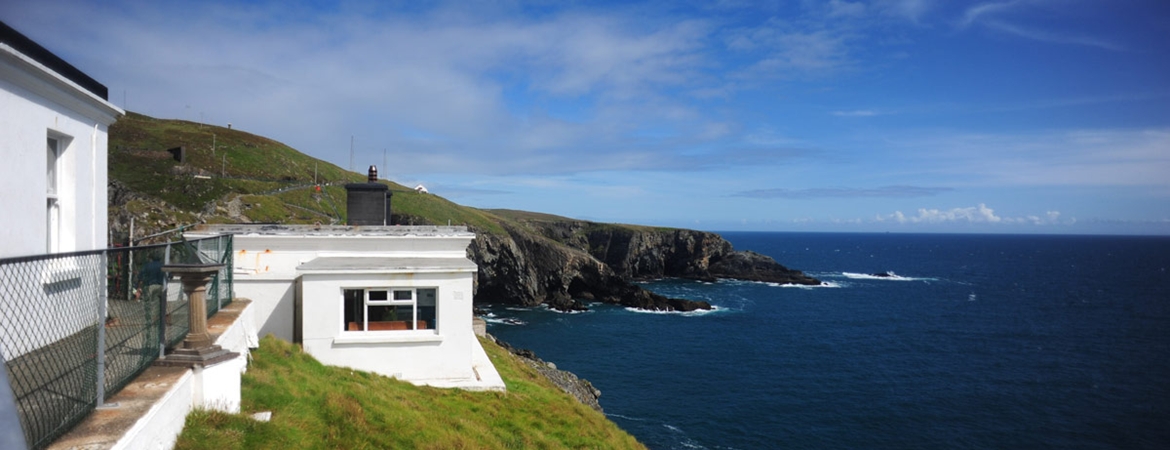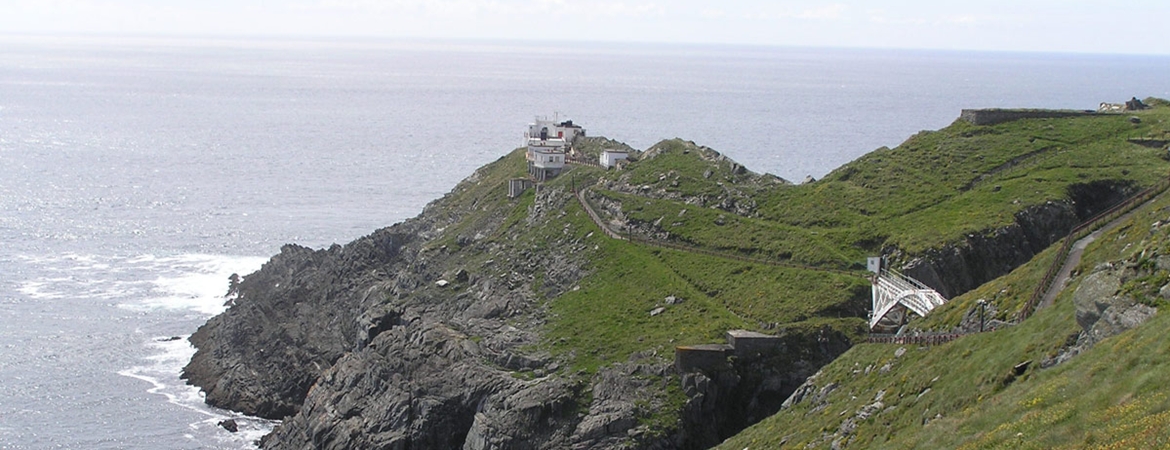On the 28 April 1905 the Board of Trade gave sanction for the erection of a lighthouse and fog signal at Mizen Head but at the Lighthouse Conference held in April 1906 it was agreed that a fog signal only was necessary at Mizen Head and that the new station should be put in the care of the Principal Keepers of Fastnet Lighthouse.
The station in on Cloghnane (or Cloghan) Island, in the south-west extremity of Ireland.
On 18 October 1907 sanction was given for the erection of a reinforced concrete bridge to give access to the Island, to be built by Messrs Thorne and Sons, of Westminster to a design by Noel Ridley at a cost of £1,272.
The SS Trada was wrecked at Mizen Head on 22 December 1908. Sixty three lives were saved by the resident engineer and workmen at the site. At the enquiry held on 26 January 1909 the Master of the vessel blamed the disaster on the lack of a fog signal at Mizen Head.
On 3 May 1909 the fog signal was established and Keepers' dwellings were built. The Fog Signal was an explosive charge fired at intervals. In July 1914 the dwellings were whitewashed so as to act as a better daymark.
There was an armed raid on Mizen Head on 21 May 1920 and practically all the explosives were taken. As no protection was offered to the station by the Government the Board withdrew explosive fog signals from all stations around the coast. The fog signal was re-established on 29 February 1924. On 1st June 1934 the character of the fog signal was changed from 2 shots every 7½ minutes to 2 shots every 5 minute with a brilliant flash accompanying the fog signal when sounded by night. This flash was discontinued during World War Two and re-introduced in 1949. The explosive type fog signal was finally withdrawn in 1969.
A Radiobeacon (the first in Ireland) was installed and put into operation on 1 January 1931, at a cost of £10,017. In more recent times utilisation of radio direction finders by mariners has been to a great extent superceded by more modern technology. For this reason, the Commissioners discontinued their Medium Frequency Radiobeacon service on 1st February 1999.
In May 1931 Mizen Head was taken out of the care of the Principal Keeper of Fastnet and a Principal Keeper of Mizen Head was appointed, with two Assistant Keepers, one of whom also did duty at Crookhaven.
A light white occulting light with the character Oc W 4 seconds was established at Mizen Head on 1st October 1959. On 10th October 1968 the range of the light was increased to 16 nautical miles.
A racon (radar transponder beacon) was established in July 1968.
Mizen Head light was converted to automatic operation and, as a consequence, the Lightkeepers were permanently withdrawn in March 1993. Subsequently the Commissioners leased surplus buildings to Mizen Tourism Co-operative Society Ltd, a local community group, to create the Mizen Vision visitor centre.
An encrypted Differential Global Positioning System (DGPS) station provided by Scorpio Navigation Services on a commercial, user pays basis, commenced on 4 June 1993. This service terminated on 28 February 1998. In June 1998 the Commissioners of Irish lights commenced their own unencrypted DGPS service on a trial basis. On 1st July 2002 validation was successfully completed and operational capability achieved.
The station in on Cloghnane (or Cloghan) Island, in the south-west extremity of Ireland.
On 18 October 1907 sanction was given for the erection of a reinforced concrete bridge to give access to the Island, to be built by Messrs Thorne and Sons, of Westminster to a design by Noel Ridley at a cost of £1,272.
The SS Trada was wrecked at Mizen Head on 22 December 1908. Sixty three lives were saved by the resident engineer and workmen at the site. At the enquiry held on 26 January 1909 the Master of the vessel blamed the disaster on the lack of a fog signal at Mizen Head.
On 3 May 1909 the fog signal was established and Keepers' dwellings were built. The Fog Signal was an explosive charge fired at intervals. In July 1914 the dwellings were whitewashed so as to act as a better daymark.
There was an armed raid on Mizen Head on 21 May 1920 and practically all the explosives were taken. As no protection was offered to the station by the Government the Board withdrew explosive fog signals from all stations around the coast. The fog signal was re-established on 29 February 1924. On 1st June 1934 the character of the fog signal was changed from 2 shots every 7½ minutes to 2 shots every 5 minute with a brilliant flash accompanying the fog signal when sounded by night. This flash was discontinued during World War Two and re-introduced in 1949. The explosive type fog signal was finally withdrawn in 1969.
A Radiobeacon (the first in Ireland) was installed and put into operation on 1 January 1931, at a cost of £10,017. In more recent times utilisation of radio direction finders by mariners has been to a great extent superceded by more modern technology. For this reason, the Commissioners discontinued their Medium Frequency Radiobeacon service on 1st February 1999.
In May 1931 Mizen Head was taken out of the care of the Principal Keeper of Fastnet and a Principal Keeper of Mizen Head was appointed, with two Assistant Keepers, one of whom also did duty at Crookhaven.
A light white occulting light with the character Oc W 4 seconds was established at Mizen Head on 1st October 1959. On 10th October 1968 the range of the light was increased to 16 nautical miles.
A racon (radar transponder beacon) was established in July 1968.
Mizen Head light was converted to automatic operation and, as a consequence, the Lightkeepers were permanently withdrawn in March 1993. Subsequently the Commissioners leased surplus buildings to Mizen Tourism Co-operative Society Ltd, a local community group, to create the Mizen Vision visitor centre.
An encrypted Differential Global Positioning System (DGPS) station provided by Scorpio Navigation Services on a commercial, user pays basis, commenced on 4 June 1993. This service terminated on 28 February 1998. In June 1998 the Commissioners of Irish lights commenced their own unencrypted DGPS service on a trial basis. On 1st July 2002 validation was successfully completed and operational capability achieved.





